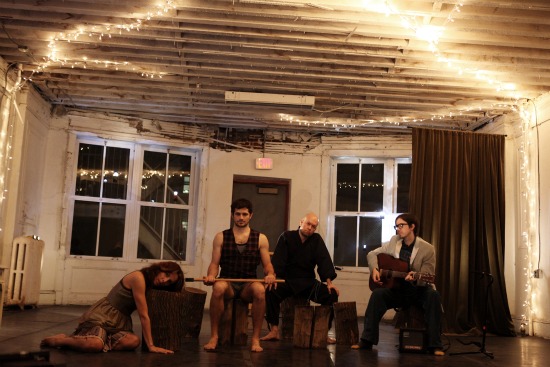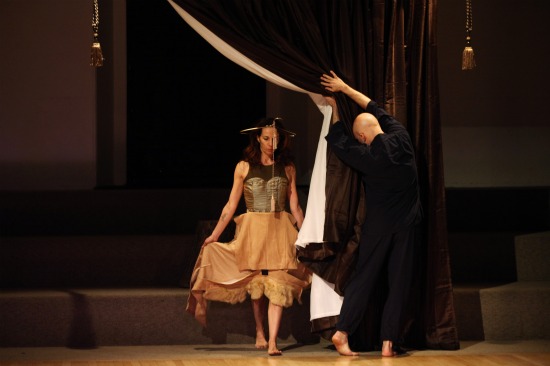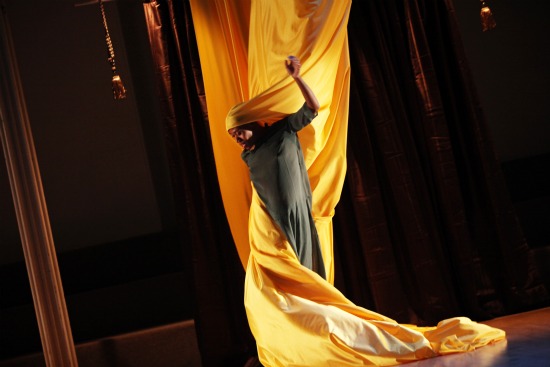A number of the people rising from their seats and milling around Danspace St. Mark’s after Keely Garfield’s Twin Pines exchange grins and nods and fond remarks along the lines of “That’s Keely for you!” The word “quirky” is heard. Watching a piece by Garfield can be like entering someone’s disheveled home at a bad time and wondering, “What’s been going on here?” Or like entering Garfield’s brilliantly unkempt head. As a performer, indeed, she often looks like a housewife in distress, with more to keep track of and more people to clean up after than she can manage. Dancing, she can appear exultant, but more often she’s gloomy, rolling her eyes as if some unknown fate were compelling her to throw her legs around and make dagger-sharp gestures.
Here’s what I know for sure about Twin Pines (seen at Danspace January 19 through 21) . In October 2010, it premiered at Duo Multicultural Arts Center, where it moved among several floors. Although the piece’s subtitle is given as “Part real, Part arboreal,” a note after the credits begs to differ: “To Be Clear: Twin Pines is presented in two parts—Stump and Flesh. . . .”. There’s also a pungent sentence: “Two trees walk into a forest; one says to the other, ‘We’ll never get out of here alive.’” Plus a mention of myths in which humans become trees. These road maps may or may not guide us through the woods.
Before anything has happened, here’s what I see from my seat in the rows occupying one of the church’s long sides. Fat logs standing on end, an axe, a guitar, a harmonium, a microphone, several big green vases (one with a green hard hat inverted over it), an upright vacuum cleaner, an ornate side table with what could be a bottle of milk on it (but isn’t), a little lamp with another helmet for a shade, a cushion, a ukulele, a doormat, two hanging silk arrases with tasseled ropes.
Once Twin Pines has started, my brain starts careering around this postmodern playground and what takes place there. This piece is a mess. This piece is a very smart mess. This piece ran away with itself. I’m puzzled, frustrated, charmed. I’m having a very good time.

Twin Pines (2010 version). Left to right: Garfield, Steffensen, Phillips, and Brookshire. Photo: Julieta Cervantes
In the first twisty bit, Garfield—wearing a knee-length, full-skirted, gray taffeta party dress—is sitting slumped on the floor, her head pillowed on a log. Seated on other stumps, Brandin Steffensen and Anthony Phillips join composer Matthew Brookshire as he plucks his guitar and sweetly sings the Beach Boys’ “Don’t Worry Baby” (“Well, it’s been building up inside of me for, oh, I don’t know how long”). Steffensen is costumed in a red plaid vest and not much else; Phillips wears a black martial arts outfit. Garfield takes little comfort from the song.
We’re wandering around in what could be a fairytale, a myth, and/or a dream, in which alluring paths stop short or vanish into the underbrush. Actions recur in strange places at surprising times; for instance, in the course of several dances, people wipe their feet in a doggy way (not necessarily near the mat). Childhood games of make-believe merge with serious, even drastic acts. Two white wire coat hangers become fluttery wings for Garfield, later a crown awkwardly decorated with a tassel-ended rope. The performers crawl and meow for a few seconds. Lightweight sleeping bags suddenly appear as aprons or long hooded cloaks. Garfield stares at Steffensen when he briefly becomes a fuddled old man who has difficulty getting his feet into a pair of white rubber flip-flops. The greatly gifted Brookshire moves from one instrument to another, singing lyrics that seem apt at the moment, such as “stuck in the forest” and “everything’s gonna be alright.”
The twinning aspect arises in duets. A little while after a combat for the two men, Steffensen smites Phillips with the axe behind one of the silk hangings. Omagbitse Omagbemi, who appears only in the second part, dances (wonderfully) side by side with Steffensen, while Phillips, seated on the floor, reads instructions on how to relax body and mind. Garfield and Omagbemi also dance together; perhaps the transformations both go through at different times—removing their blouses to climb, bare-breasted, onto Steffensen’s shoulder, and then being handed green shifts to wear—refer to Apollo’s pursuit of the virginal Daphne and her evasive tactic of turning into a laurel tree. And one of these metamorphoses is followed closely by the line “No matter how sorry you are, the teacup is broken,” which aligns itself with two very small cups and saucers that appear out of nowhere.
Sometimes the dancing in Twin Pines takes the form of carefully shaped journeys delineating the space around the marvelous performers; sometimes it flails the air. Mysteries abound. Garfield has said she is creating a kind of pictorial narrative of how roots are set down, limbs branch out, leaves appear. In this analogy to the growth and formation of human emotions, trunks also crack and fall, and seeds produce strange offspring. The thread Garfield would have us follow (or not), veers, tangles, disappears, and pops up transformed. A serious story masquerades as rainy-day games in the mind’s attic.



First of all I would like to say terrific
blog! I had a quick question which I’d like to ask if you don’t mind.
I was curious to find out how you center yourself and clear your head
before writing. I’ve had a tough time clearing my thoughts in getting my thoughts out. I truly do take pleasure in writing however it just seems like the first 10 to 15 minutes tend to be lost just trying to figure out how to begin. Any suggestions or hints? Cheers!